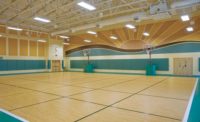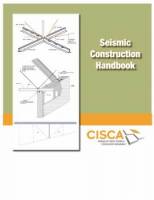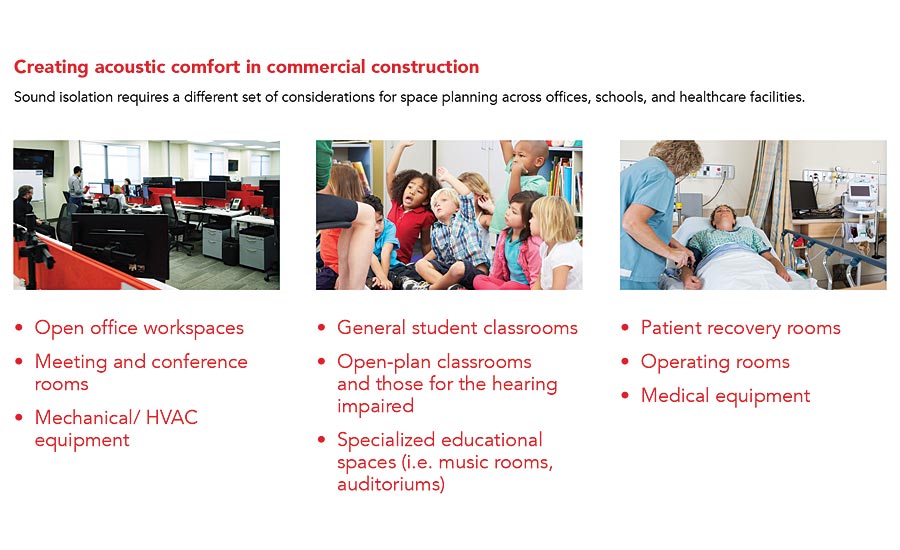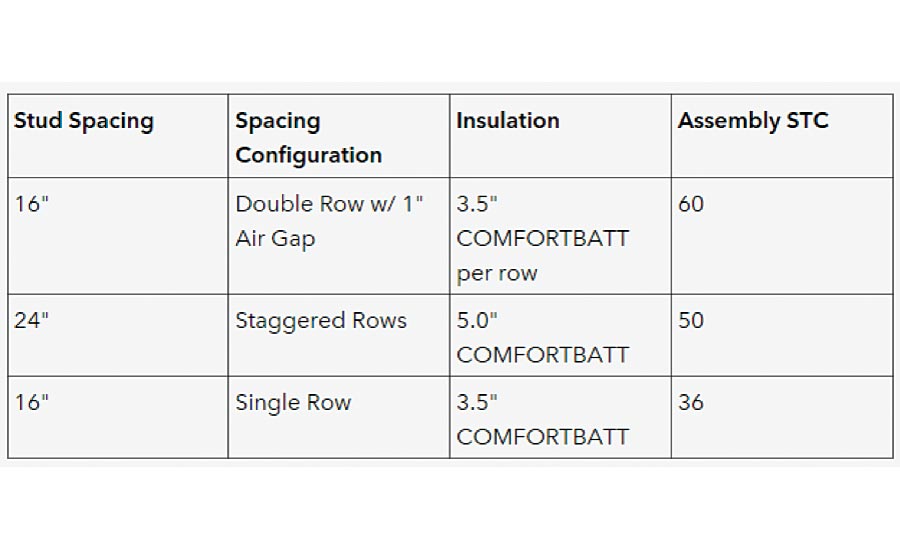Controlling Interior Acoustics (Part 2)
Minimizing Interior Noise To Achieve Sound Isolation (Sound Blocking).




This table illustrates the differences that can be achieved in STC rating using air gaps, staggered rows of studs and a single row of studs.








When it comes to creating a healthier, more comfortable, productive and less disruptive indoor environment, the right solutions, including insulation and other acoustic building materials, can reduce unwanted noise and improve indoor environmental quality. Prioritizing acoustics and designing for occupant comfort, along with using low-emitting materials that are resistant to mold and mildew, specifically to achieve higher IEQ is increasingly a focus among building owners, designers, consultants and architects. This is particularly so, as the industry moves toward more sustainable, high performance buildings.
Planning from the outset of any project is key to maximizing acoustic performance. It’s also important to consider legislative requirements, standards, and voluntary guidelines. For example, building code requirements for insulation used in fire separations or exterior walls and roofs are a central component of developing acoustic environments that support occupant health, learning, productivity, recovery, safety, and wellbeing. However, the building envelope is only one part of a good overall acoustic plan. A comprehensive approach—one that also includes interior acoustic design and considers the acoustic performance and impact of materials within the building—is crucial to a building’s intended use and to how its spaces are experienced.
Occupant auditory comfort should be accounted for in the interior acoustics plan, which means considering noise from all potential sources, including the interior where the right selection of ventilation, heating, cooling, and privacy may be overlooked.
As when optimizing the acoustic experience by addressing noise from the exterior, the best time to address interior noise is during the design phase. Managing the acoustics of a built environment, by its most simple definition, is done by the right combination of blocking and absorbing sound (one example being a sound barrier wall with acoustic insulation inside). When it comes to blocking interior sound (we will also refer to this interchangeably as “sound isolation”), the materials selected to support the acoustics objectives matter as much as the design of the space itself.
What is Sound Isolation?
While “blocking” is the more commonly used term, sound isolation is the ability to block sound transmission from one room or area to another (between the source and the receiver). This may also be needed in instances where the room is upstairs or right next door.
Blocking (sound isolation) occurs when sound bounces off of hard, reflective surfaces enclosing a space, such as walls or partitions, windows, or the floor instead of passing through them.
Absorption, conversely, is what happens when a material has the ability to absorb and dampen the sound inside a room or space. Softer materials, such as carpets, fabric panels or acoustic ceiling tiles, are most often used for this purpose.
The main design approach for acceptable sound isolation is using mass. The heavier the sound isolating structure, the more sound isolation is provided. But increasing the mass quickly becomes expensive and impractical. The next design approach to be considered for sound isolation is separating (or decoupling) assembly materials to stop the transfer of sound energy though them. This soundproofing technique is often used in “floating” walls or floors but doesn’t have to be done by constructing a massive concrete slab or wall.
When designing for sound isolation, ensure to consider all directions that sound can travel—horizontally between rooms on the same floor as well as vertically between those on different floors. The sound can be airborne such as talking or structure-borne (impact) such as walking.
Why Use Acoustic Insulation?
Acoustic insulation can be applied to almost any assembly in any area to increase the sound isolation performance. As acoustic comfort in buildings becomes a greater priority for renovation, retrofit or new construction projects, acoustic insulation in walls and floor/ceiling assemblies takes on greater importance in minimizing noise levels for occupants.
According to the National Institute of Building Sciences, providing a comfortable environment for employees contributes significantly to their productivity, optimum performance and reduced absenteeism. There is also a steadily increasing demand for acoustic comfort driven by occupants and building professionals who recognize the importance it plays in our daily lives.
In residential applications, ensuring the right acoustic room design including sound-blocking walls is essential, especially if one is looking for how to muffle sound through a shared wall. Acoustics planning is also an important component if one is looking to convert your basement into a home theatre or music room where a sound barrier to the floor above may be needed. Acoustics room design can also help to minimize distractions in a home office or reduce the impact noise from noisy neighbors.
For commercial construction, the value of acoustic insulation is significant to help in several areas of sound control, including:
People working in offices—be they open-plan environments with cubicles, private rooms, or large meeting spaces – will likely encounter sound from mechanical equipment in adjacent spaces, copy machines and printers, and phones and voices from other people within the workplace. Creating office privacy and ensuring open plan office noise reduction will lead to a happier, healthier and more productive workforce.
Noise in many healthcare facilities is a 24/7 phenomenon; the source could be anything from loud equipment used in patient care, conversations between patients and care teams or visitors. Making hospital acoustics a priority and protecting patient confidentiality in a busy healthcare setting a valuable part of the design process.
Schools and educational institutions: Students and teachers alike will experience noise in the form of hallway foot traffic, conversations, other classrooms, mechanical equipment, and conversations inside the classroom. School acoustics are an important component of creating a positive and productive learning environment.
There are several different ways to achieve the sound isolation goals of a space. The construction assemblies used and the building materials that are specified and selected are only two examples. Sound blocking or isolation is a key component of any acoustics plan and there are numerous product options available to help you achieve the desired sound transmission class rating for your space including stone wool insulation.
In order to take the best approach for the project at hand, let’s first look at what sound isolation actually is and how it’s measured.
Sound Isolation and How it is Measured
To understand how sound isolation is measured, first get to know more about STC ratings. STC speaks broadly to the role of building components to reduce sound transmission through wall assemblies, floors/ceilings, windows, and doors, from one space to another.
STC ratings are calculated by measuring sound transmission loss at 16 data points in a frequency range of 125 to 4,000 Hertz—with Hertz being the frequency of a sound wave.
Once these 16 points have been charted they are compared against contour curves of established STC ratings. The contour that most closely matches the test data is then used to define the STC rating of that assembly. STC ratings must be certified by a qualified lab such as the Intertek Group, Element Materials Technology, and Alion Science’s Riverbank Acoustical Labratories.
The STC visual outlines assembly STC ratings and what it means in terms of speech privacy for occupants including STC 50 where “very loud sounds such as musical instruments or a stereo can be faintly heard.”
STC Ratings of Assemblies and Systems
The STC rating quantifies how much a particular soundproofing assembly or system such as an interior wall assembly, reduces sound passing through it.
The STC rating is only roughly indicative of the number of decibels that will be reduced and represents a means of specifying materials for acoustical wall assemblies that will provide the required noise reduction (i.e. an assembly comprised of 5/8-inch gypsum board, steel studs and SAFE’n’SOUND insulation will produce an STC rating of 52 while an assembly comprised of 5/8-inch gypsum board, wood studs, resilient channels, and the insulation will produce an STC rating of 45).
STC ratings are most typically used for interior sound transmission as the frequency range used for it lacks certain low frequencies that are commonly found in the exterior environment. Because of this, exterior noise isolation is characterized using a different metric, outdoor indoor transmission class.
Understanding STC and STC Ratings
The International Building Code requires lab tested STC 50 between dwellings (i.e. for walls and floors/ceilings that separate dwellings in new construction, also known as “party walls.” Under the acoustic legislation, this is a minimal amount of sound isolation, and at this level, you may still be disturbed by neighbors in adjacent dwellings.
So what is a good STC rating and how is it achieved? In general, that would vary based on the building materials—walls, for example, as compared to windows. In general, higher STC ratings are achievable with acoustical wall assemblies than with windows. For wall assemblies, STC 55 to STC 60 assembly ratings are recommended for an improved occupant experience.
Higher STC ratings are always indicative of greater sound blocking, however, as the performance follows a logarithmic scale, the STC number is not necessarily the sum of its parts. As an example, if you have an STC 33 wall assembly and decide to add another sheet or layer of drywall that alone has an STC rating of 10, their combined performance is not STC 43 (33+10). When the new assembly is tested, that extra layer of drywall will only increase the assembly performance by 1-3 STC points.
How to Use Sound Isolation for Speech Privacy
Speech privacy requires optimizing the sound isolation between rooms to ensure an inability to understand speech. Factors that contribute to speech privacy include sound amplitude, background noise level, attenuation, and listener language skills. Examples of speech that most likely require measure to maintain privacy include a patient in the neighbouring room, a private call in an office, or noise from the adjacent classrooms.
Good speech privacy has a Privacy Index > 95 percent or Speech Privacy Class > 80, where PI is calculated using the following formula: PI = (1 – Articulation Class) x 100 percent. It’s basically the opposite of speech intelligibility. The measure has gained widespread adoption among acousticians in North America and ASTM standards have identified different types of speech privacy, which vary by the need:
Normal Privacy: when approximately five to twenty percent of anything that is said may be understood by a casual listener. This is considered the baseline for achieving acoustic comfort in most conditions and corresponds to a PI of 80% to 95%
Confidential Privacy: when five percent or less of anything that is said may be understood, but that the meaning of conversation cannot be determined by a casual listener. It is extremely difficult to achieve this level of privacy in an “open-landscape” office but quite achievable in enclosed private offices. This corresponds to a PI of 95 percent or greater.
Secure Privacy: when zero percent of what is said can be heard or understood. This level of speech privacy is the most difficult, and therefore expensive, level to achieve. Depending on the level of speech privacy required, different construction techniques or assemblies and materials will be required.
What Materials Can Block Sound?
Regardless of the type of building and its unique needs and challenges, acoustics plays a critical role in supporting Indoor Environmental Quality. IEQ is a fundamental principle in many voluntary certification programs such as LEED, the Facility Guidelines Institute guidelines, and the WELL Building Standard. Acoustics is one of the components that will significantly affect occupant comfort and well-being.
It may surprise some to learn that sound travels easily through wood framing and the layer of drywall—usually the largest point of connection between neighbors, whether in a home or commercial building. From the perspective of acoustics, it means planning properly with the right construction assemblies and insulation materials. While the best time to insulate and soundproof walls is during new construction, it is possible to add sound isolation to existing walls without tearing off the drywall.
With proper insulation and mass, walls can definitely help block out noise, but this still isn’t enough. In fact, closed offices often give the illusion of privacy. Even with appropriate insulation, noise will still find a way through other, less obvious, open spaces called flanking paths. For example, ceiling systems will always have noise leaks—created by installing light fixtures and HVAC ventilation air devices, among others— which make them even less effective at blocking or insulating sound. Since ceiling tiles are poor at blocking sound because they don’t have sufficient mass, they should be selected based on their sound-absorbing performance known as Noise Reduction Coefficient. The higher the NRC the better. Wall assemblies are also susceptible to flanking paths such as doors, windows, and outlets. The open gaps associated with these elements allow the transmission of noise between rooms.
As a more comprehensive soundproofing solution, full-height walls that extend from the structural floor to the structural floor or roof above are recommended. Alternately, if existing walls do not extend full height, they can be modified with plenum barriers to provide additional sound-blocking benefits. From an acoustics perspective, full-height walls are the preferred design approach in almost all scenarios. They also should be used when the building design must comply with STC ratings in a standard, guideline or rating system.
Room Acoustics: Solutions for Sound Isolation
While every room in a home or non-residential building and the surfaces within it will react differently to different frequencies of sound, the insulation within the assemblies has a significant impact on the room acoustics and the ability to block or insulate noise.
Insulating walls is one part of the equation that is essential for any level of speech privacy. But not all interior insulation products are created equal, which makes finding the right solution an important decision during the design and construction processes.
How to Prevent Sound from Entering a Room
Limiting the transmission of sound from one area to another requires the use of materials that have the ability to enclose the source of the noise and form a barrier that absorbs vibrations between the source and the receiver.
There are different forms of insulation products that may be specified and applied to help minimize sound levels and enhance acoustic comfort in homes and non-residential buildings. These include cellulose, fiberglass, foam and stone wool (or mineral wool as it’s often referred).
Consider stone wool if you are tired of noise in your apartment, office, home or classroom, and are looking to lower the distractions for building occupants. Such insulation provides strong sound absorption due to its composition, specifically its density and non-directional fiber structure.
Insulation solutions, such as stone wool, will help soundproof and insulate spaces with the proven durability to last for the long term without seeing a decrease in performance. When your walls are properly insulated, you will reduce airborne noises coming from other rooms, resulting in a much quieter space.
Using Interior Wall Insulation for Sound Control
When soundproofing an interior wall, you must first determine whether your intended goal is to block out noise or whether you’re trying to improve the quality of sound within a space. Interior wall insulation can then serve as a sound barrier that improves soundproofing performance of the space keeping noise from traveling from one room to another.
It’s important to know that soundproofing materials for walls, floors, ceilings, and doors are often denser materials that add mass and reflect noise—this can have the effect of “trapping” noise within a space. Sound absorbing materials, on the other hand, are more often porous and lightweight and keep noise from bouncing around inside a room. So if speech privacy is the only goal, blocking alone would suffice. If speech intelligibility is also required, then a combination of blocking and absorption is necessary.
A key feature in any wall assembly for reducing low-frequency sound transmission is the use of air gaps combined with acoustic insulation. Air gaps effectively “decouple” the main wall assembly components from each other, reducing the ability of low-frequency sounds to easily transmit through the full assembly.
The table on page 50 illustrates the differences that can be achieved in STC rating using air gaps, staggered rows of studs, and single rows of studs. In all cases, studs are standard 2x4 wood and each assembly has a 5/8-inch gypsum board on either side. Two examples of wall assembly construction techniques including “double leaf” or mass-air-mass construction—used to improve sound transmission loss, and using resilient channels and air sealing when designing acoustic systems for your walls and roofs.
Conclusion
Managing interior noise doesn’t have to be complicated. It begins by understanding how sound isolation or blocking, and absorption, work differently to help achieve the objectives of a space. While sound isolation is best achieved by insulating interior walls, there are different options to help achieve the desired outcome, so knowing which construction materials to use in different assemblies is essential.
STC ratings of assemblies can help with the decision process by identifying a product’s ability to reduce sound transmission between rooms. With all of the options available, building design and construction pros will benefit from understanding the performance advantages possible with products such as stone wool insulation for soundproofing.
Ultimately, selecting the best construction materials to create wall assemblies that deliver acoustic comfort in buildings and homes at the beginning of a project to meet those objectives will help ensure the finished product has a high degree of IEQ.
Looking for a reprint of this article?
From high-res PDFs to custom plaques, order your copy today!















